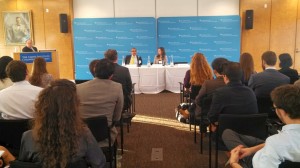Author: Guest127
-

Connecting Students, Alumni at Annual Networking Day
On Nov. 16, the Master of Public Administration in Environmental Science and Policy program held its annual Alumni Networking Day. The event, hosted by The Earth Institute, welcomed more than 70 alumni, current students and faculty for a panel and networking reception held at Columbia’s School of International and Public Affairs.
-

GlaxoSmithKline Supports African Health Workers Campaign
The Earth Institute and its corporate partner, global healthcare company GlaxoSmithKline are embarking on a new project to broadly expand the reach of healthcare services in sub-Saharan Africa. In collaboration with the One Million Community Health Workers Campaign, the new project will develop an online information dashboard that will help streamline community health worker operations…
-

Is Sustainability Sustainable in a Post-Bloomberg NYC?
With the end of Mayor Michael Bloomberg’s tenure drawing near, many are speculating which of his policies will survive the next administration. New York City’s comprehensive environmental plan, PlaNYC 2030: A Greener, Greater New York, has been championed politically by Bloomberg, but is grounded in science and data, and performance management. It has demonstrated progress,…
-

The State and Future of Congestion Pricing in China
To combat urban air pollution and traffic problems, some propose congestion pricing as a cost-effective policy to reduce pollution and improve productivity through improved travel speeds. Cities in China could implement this policy and ameliorate some of the negative effects of congestion-caused pollution. So why is congestion pricing dead on arrival in China?
-

Perspective: Q&A with Development Practitioner Ignacio Urrutia
By Sarayu Adeni With careful planning and a methodical approach, Ignacio Urrutia, MPA-DP ‘13, aims to solve problems before they happen. Currently working in South Asia’s Disaster Risk Management (DRM) and Climate Change Unit at the World Bank, he brought over five years of experience at the World Bank and UNDP in Washington, D.C. and…
-

Artists, Scientists Match up at ‘Speed Dating’ Event
During the dates, participants shared with one another work they had done on cell phones and tablets, and exchanged information, making plans to talk in the future. Daters everywhere were rapt in conversation, and you could see an occasional wild hand gesturing in excitement.
-

Artist/Scientist Speed Dating Event on Nov. 6
Have you ever wondered what can spark collaboration between artists and scientists? Witness as first “dates” unfold between two featured pairs of artists and scientists, and then have your turn at meeting potential collaborators of your opposite discipline.
-

Perspective: A Q&A with Development Practitioner Sarah Curran
Sarah Curran, Master of Public Administration in Development Practice (MDP), Class of 2011, believes that addressing complex global issues starts with a meal. As a Program Manager for the Center on Globalization and Sustainable Development at the Earth Institute, she brings a full plate of organizational and information experience, from back home in the UK…
